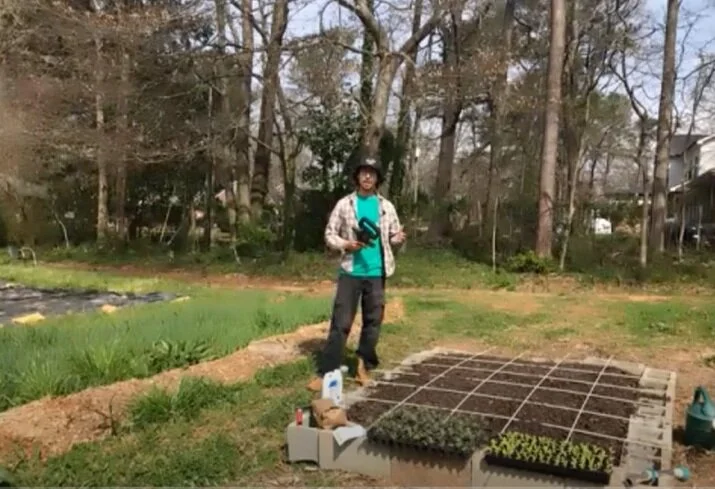By Monica Ponce
Monica Ponce is a Worker-Owner at Love is Love Cooperative Farm and has been on the Board of Directors of Georgia Organics since 2020.
Miriam Beté Perez and Finca Clave de Sol. Photo courtesy of COMSA.
Monica Ponce. Photo courtesy of Love Cooperative Farm.
For years now, I have been getting my hands dirty on the farm. It’s been a long exploration of different landscapes, soils, plants, and practices. Along the way, I have had the chance to connect with farmers near and far, and I continue to be wowed by the stories I hear and the things I learn from fellow farmers.
I was recently invited by Café Campesino, a Georgia-based organic coffee roaster and wholesaler, to interview Miriam Pérez a member of Café Orgánico Marcala S.A. (COMSA). COMSA is a group that has been a partner of Café Campesino through their importing co-op, Cooperative Coffees, since 2014. As a member of Love is Love Cooperative Farm, a worker-owned cooperative on 70 acres in Mansfield, Georgia, I was thrilled to have the chance to connect with another cooperative grower to learn more about her work! It’s awe-inspiring to see the care put into the plants and the alignment of her growing practices with the lunar calendar and larger ecology of the farm.
If you want to support COMSA, pick up a couple of bags of Café Campesino Coffee. When you purchase Café Campesino’s Georgia Organics Special Blend Coffee, a portion of sales will be donated to Georgia Organics, so it’s a great way to support regenerative and organic farmers in Georgia, too!
I hope our conversation inspires you to savor your sip.
Monica Ponce: What certifications or third-party labeling do you have that has helped increase your markets?
Miriam Beté Perez: Organic and Fair Trade certifications.
Monica: What is it like to cultivate coffee?
Miriam: Cultivating coffee is a passion for me!
I started at the age of 6 on my grandfather's farms. For me and my cousins, going to the coffee farms meant hiking along trails, running, playing, and having a free life. We would arrive at the farm to harvest coffee beans and be in contact with Mother Earth.
The cultivation involves several processes which we call cultivation tasks. We start by harvesting and selecting the seeds of the plants that have had the best development in the farm, after being cultivated for more than 3 years. Next, we create a coffee nursery, where the babies grow for 2 to 3 months. Then we continue with the selection and transplant the strongest and best-developed plants to the soil prepared with organic ingredients. These plants grow there in the nursery and/or shed for 3 to 4 months. Then they are transferred to the definitive field and the small trees are planted in a previously elaborated and prepared hole, where organic fertilizer was also added the previous year.
Image: Miriam Perez. Photo courtesy of COMSA.
Monica: How long does it take for the crop to be ready for harvesting?
Miriam: The coffee crop is ready for harvesting in the third year.
Monica: In what season of the year is the coffee harvest?
Miriam: The harvest season in the Marcala region begins in November and ends in April.
Monica: What is the harvesting process like?
Miriam: When the collection begins, two containers are used, they can be bags or baskets. These are attached to the body of the person who is going to carry out the coffee cherry collection task. These containers are used to deposit the green, dry, and over-fermented beans on one side and the red cherries in the other container.
At 3 pm, the coffee is received by the harvesters, weighing the coffee cherries and keeping a record of the daily deliveries for each person who harvests them.
The red coffee cherries are placed in a sieve to continue with the selection of green, dry, and fermented beans that are mixed at the time of harvest. Then the depulping process is carried out to obtain a honey-processed coffee and/or it is taken to the sun-drying patio to obtain a natural, dry cherry coffee.
Monica: What types of soils do you have and what are some of your practices to enrich/maintain the quality?
Miriam: A large part of our soils is sandy loam soils. The good agricultural practices we use to nourish the plants and soil include:
Preparation and application of organic fertilizers based on organic matter, mountain microorganisms, minerals, and living molecules.
Application of bio-preparations.
Sowing of Healing crystals.
Pranic Healing meditations over the plants.
Sowing of trees.
Planting of coffee varieties resistant to pests and diseases.
Cultivation tasks using the lunar calendar (Cleaning, pruning, de-leafing, sowing and re-sowing of coffee plants, application of solid and liquid organic fertilizers)
Coffee cherries and green, dry, and over-fermented beans still on the branch before harvest.
Monica: What are the ideal conditions for cultivating coffee?
Miriam: Under a microclimate where there are trees, bushes, fruit trees, birds, animals, and diversity of living beings in balance.
Monica: Has the weather become more unpredictable for you and how have you adapted/managed?
Monitoring the temperature, relative humidity according to each season of the year, the movements of the moon and the stars in the cosmos are indicators that allow us to manage the diversity and times in the coffee farm.
Monica: How many people work on the farm and do the farmers live on or near the farm?
Miriam: Temporarily, 6 people work on the farm, and up to 20 people work temporarily, especially during coffee harvesting and processing. Two families live on the farm, and the other families are neighbors, while others live away.
Monica: How did you find this cooperative as farmers?
Miriam: We didn't find it, we started it, thanks to the importance of benefits received from being in a farmer organization.
To learn more about COMSA and Finca la Fortaleza (Marcala) visit coopcoffees.coop/comsa or follow the co-op on Facebook (COMSA - Marcala) and Instagram (@comsamarcalaoficial).
To learn more about Café Campesino visit cafecampesino.com or follow the Georgia roastery on Facebook (Cafe Campesino Roastery) and Instagram (@cafecampesino).
To learn more about Love is Love Cooperative Farm visit loveislovefarm.com or follow the co-op on Facebook (Love is Love Farm) and Instagram (@loveislovefarm).
To learn more about Georgia Organics visit georgiaorganics.org or follow us on Facebook, Instagram, Twitter, LinkedIn, and YouTube by searching (Georgia Organics).































